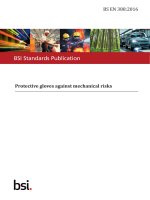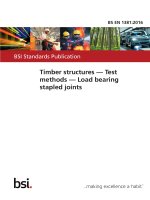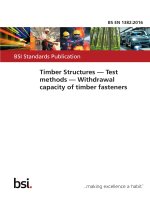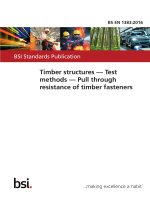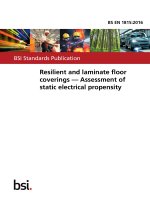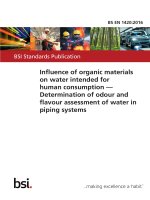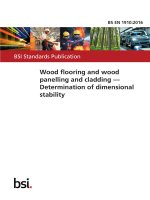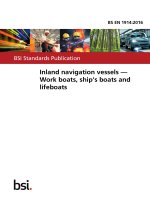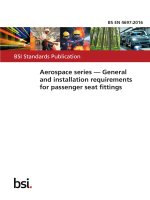Bsi bs en 00458 2016
Bạn đang xem bản rút gọn của tài liệu. Xem và tải ngay bản đầy đủ của tài liệu tại đây (1.28 MB, 54 trang )
BS EN 458:2016
BSI Standards Publication
Hearing protectors —
Recommendations for
selection, use, care and
maintenance — Guidance
document
BS EN 458:2016
BRITISH STANDARD
National foreword
This British Standard is the UK implementation of EN 458:2016. It
supersedes BS EN 458:2004 which is withdrawn.
The UK participation in its preparation was entrusted to Technical
Committee PH/7, Hearing protectors.
A list of organizations represented on this committee can be
obtained on request to its secretary.
This publication does not purport to include all the necessary
provisions of a contract. Users are responsible for its correct
application.
© The British Standards Institution 2016. Published by BSI Standards
Limited 2016
ISBN 978 0 580 82040 3
ICS 13.340.20
Compliance with a British Standard cannot confer immunity from
legal obligations.
This British Standard was published under the authority of the
Standards Policy and Strategy Committee on 31 March 2016.
Amendments issued since publication
Date
Text affected
BS EN 458:2016
EN 458
EUROPEAN STANDARD
NORME EUROPÉENNE
EUROPÄISCHE NORM
March 2016
ICS 13.340.20
Supersedes EN 458:2004
English Version
Hearing protectors - Recommendations for selection, use,
care and maintenance - Guidance document
Protecteurs individuels contre le bruit Recommandations relatives à la sélection, à
l'utilisation, aux précautions d'emploi et à l'entretien Document guide
Gehörschützer - Empfehlungen für Auswahl, Einsatz,
Pflege und Instandhaltung - Leitfaden
This European Standard was approved by CEN on 8 August 2015.
CEN members are bound to comply with the CEN/CENELEC Internal Regulations which stipulate the conditions for giving this
European Standard the status of a national standard without any alteration. Up-to-date lists and bibliographical references
concerning such national standards may be obtained on application to the CEN-CENELEC Management Centre or to any CEN
member.
This European Standard exists in three official versions (English, French, German). A version in any other language made by
translation under the responsibility of a CEN member into its own language and notified to the CEN-CENELEC Management
Centre has the same status as the official versions.
CEN members are the national standards bodies of Austria, Belgium, Bulgaria, Croatia, Cyprus, Czech Republic, Denmark, Estonia,
Finland, Former Yugoslav Republic of Macedonia, France, Germany, Greece, Hungary, Iceland, Ireland, Italy, Latvia, Lithuania,
Luxembourg, Malta, Netherlands, Norway, Poland, Portugal, Romania, Slovakia, Slovenia, Spain, Sweden, Switzerland, Turkey and
United Kingdom.
EUROPEAN COMMITTEE FOR STANDARDIZATION
COMITÉ EUROPÉEN DE NORMALISATION
EUROPÄISCHES KOMITEE FÜR NORMUNG
CEN-CENELEC Management Centre: Avenue Marnix 17, B-1000 Brussels
© 2016 CEN
All rights of exploitation in any form and by any means reserved
worldwide for CEN national Members.
Ref. No. EN 458:2016 E
BS EN 458:2016
EN 458:2016 (E)
Contents
Page
European foreword....................................................................................................................................................... 5
Introduction .................................................................................................................................................................... 6
1
Scope .................................................................................................................................................................... 7
2
Normative references .................................................................................................................................... 7
3
Terms and definitions ................................................................................................................................... 7
4
Symbols and abbreviations ......................................................................................................................... 9
5
5.1
5.1.1
5.1.2
5.1.3
5.2
5.2.1
5.2.2
5.2.3
5.2.4
Types of hearing protectors ........................................................................................................................ 9
Design forms ..................................................................................................................................................... 9
Earmuffs ............................................................................................................................................................. 9
Helmet mounted earmuffs ........................................................................................................................ 10
Earplugs ........................................................................................................................................................... 10
Function mode............................................................................................................................................... 10
Basic function mode .................................................................................................................................... 10
Level-dependent hearing protectors .................................................................................................... 11
Active noise reduction (ANR) protectors ............................................................................................ 11
Hearing protectors with external audio input .................................................................................. 11
6
6.1
6.2
6.2.1
6.2.2
6.2.3
6.2.4
6.3
6.3.1
6.3.2
6.3.3
6.4
6.4.1
6.4.2
6.5
6.6
6.6.1
6.6.2
6.6.3
6.6.4
6.7
6.8
6.9
6.9.1
6.9.2
Selection .......................................................................................................................................................... 12
Principles ........................................................................................................................................................ 12
Selection according to sound attenuation........................................................................................... 12
Guide to protection rating......................................................................................................................... 12
Sound attenuation in practice (Real-world attenuation) .............................................................. 13
Acoustical selection methods .................................................................................................................. 13
Selection of combination of earmuffs and earplugs ........................................................................ 15
Selection according to work environment .......................................................................................... 15
Factors of work environment – overview ........................................................................................... 15
Acoustical factors ......................................................................................................................................... 15
Environmental factors (non-acoustic) ................................................................................................. 17
Communication ............................................................................................................................................. 19
Essential work related speech communication, especially speech intelligibility ................ 19
Effects of over-protection .......................................................................................................................... 19
Compatibility with other PPE .................................................................................................................. 19
Selection according to hearing protector types ................................................................................ 19
Earmuffs – General....................................................................................................................................... 19
Helmet-mounted earmuffs ....................................................................................................................... 19
Earplugs – General ....................................................................................................................................... 19
Hearing protectors with additional function modes ....................................................................... 20
Medical disorders......................................................................................................................................... 20
Ergonomics and fitting ............................................................................................................................... 20
Conformity with relevant requirements for incorporated electronics .................................... 21
Intrinsic safety .............................................................................................................................................. 21
Electromagnetic compatibility (EMC) ................................................................................................... 21
7
7.1
7.2
7.3
7.3.1
Use ..................................................................................................................................................................... 21
General ............................................................................................................................................................. 21
Availability of hearing protectors .......................................................................................................... 21
Correct fitting ................................................................................................................................................ 21
General ............................................................................................................................................................. 21
2
BS EN 458:2016
EN 458:2016 (E)
7.3.2
7.3.3
7.3.4
7.4
7.4.1
7.4.2
7.4.3
7.4.4
7.4.5
7.4.6
7.4.7
7.4.8
7.5
7.6
7.6.1
7.6.2
7.6.3
7.7
7.8
Earmuffs ........................................................................................................................................................... 21
Earplugs ........................................................................................................................................................... 22
Fit check for hearing protectors .............................................................................................................. 22
Simultaneous use of hearing protector with other PPE ................................................................. 22
General ............................................................................................................................................................. 22
Protective clothing ....................................................................................................................................... 22
Spectacles ........................................................................................................................................................ 22
Goggles.............................................................................................................................................................. 22
Face shields ..................................................................................................................................................... 22
Hoods ................................................................................................................................................................ 23
Safety helmets ................................................................................................................................................ 23
Respiratory protection devices ............................................................................................................... 23
Speech intelligibility and signal audibility .......................................................................................... 23
Instruction and training ............................................................................................................................. 23
General ............................................................................................................................................................. 23
Information ..................................................................................................................................................... 23
Special instructions for use including training .................................................................................. 24
Period of use ................................................................................................................................................... 24
Leisure activities ........................................................................................................................................... 25
8
8.1
8.2
8.3
8.4
8.5
Care and maintenance ................................................................................................................................ 25
General ............................................................................................................................................................. 25
Hygiene and cleaning .................................................................................................................................. 25
Inspection and replacement ..................................................................................................................... 25
Storage .............................................................................................................................................................. 25
Disposal ............................................................................................................................................................ 25
Annex A (normative) Methods for assessing the sound attenuation of a passive hearing
protector .......................................................................................................................................................... 26
A.1
General ............................................................................................................................................................. 26
A.2
Octave band method .................................................................................................................................... 29
A.3
HML method ................................................................................................................................................... 30
A.4
HML check method ....................................................................................................................................... 32
A.5
SNR method..................................................................................................................................................... 33
Annex B (informative) Method for assessing the sound attenuation of a hearing protector
for impulsive noise....................................................................................................................................... 34
B.1
General ............................................................................................................................................................. 34
B.2
Method .............................................................................................................................................................. 34
Annex C (informative) Selection method for sound-restoration level-dependent hearing
protectors using HML-data........................................................................................................................ 36
C.1
General ............................................................................................................................................................. 36
C.2
Method 1: HML Method............................................................................................................................... 36
C.3
Method 2A: HML check method - Measurement check ................................................................... 37
C.4
Method 2B: HML check method - Listening method......................................................................... 37
Annex D (informative) Selection method for active noise reduction hearing protectors ................. 38
Annex E (informative) Calculation method for hearing protectors with audio input ........................ 39
E.1
General ............................................................................................................................................................. 39
3
BS EN 458:2016
EN 458:2016 (E)
E.2
Method ............................................................................................................................................................. 39
Annex F (informative) Improving field performance and special instructions for use ..................... 41
F.1
Improving field performance .................................................................................................................. 41
F.2
Special instructions for optimum use ................................................................................................... 42
Annex G (informative) Further guidance on fit check methods for earplugs ........................................ 45
G.1
General information.................................................................................................................................... 45
G.2
Fit check methods suitable for all types of earplugs ....................................................................... 45
G.3
Fit check method exclusive to custom moulded earplugs ............................................................. 46
Annex H (informative) Noise Types ...................................................................................................................... 47
4
BS EN 458:2016
EN 458:2016 (E)
European foreword
This document (EN 458:2016) has been prepared by Technical Committee CEN/TC 159 “Hearing
protectors”, the secretariat of which is held by DIN.
This European Standard shall be given the status of a national standard, either by publication of an
identical text or by endorsement, at the latest by September 2016, and conflicting national standards
shall be withdrawn at the latest by September 2016.
Attention is drawn to the possibility that some of the elements of this document may be the subject of
patent rights. CEN [and/or CENELEC] shall not be held responsible for identifying any or all such patent
rights.
This document supersedes EN 458:2004.
This document has been prepared under a mandate given to CEN by the European Commission and the
European Free Trade Association.
According to the CEN-CENELEC Internal Regulations, the national standards organizations of the
following countries are bound to implement this European Standard: Austria, Belgium, Bulgaria,
Croatia, Cyprus, Czech Republic, Denmark, Estonia, Finland, Former Yugoslav Republic of Macedonia,
France, Germany, Greece, Hungary, Iceland, Ireland, Italy, Latvia, Lithuania, Luxembourg, Malta,
Netherlands, Norway, Poland, Portugal, Romania, Slovakia, Slovenia, Spain, Sweden, Switzerland,
Turkey and the United Kingdom.
5
BS EN 458:2016
EN 458:2016 (E)
Introduction
This European Standard is intended to guide employers, supervisors and safety advisors. Additionally,
the standard gives information to all who need to use hearing protectors.
Hearing protectors are items of personal protective equipment (PPE) intended to reduce the harmful
effects that sound and noise may have on the hearing.
Guidance is provided on how to best select, use and take care of such devices. Tools to estimate the
noise exposure level, when a certain hearing protector is used, are also provided.
National bodies may develop national application documents based on this standard.
Hearing protectors are generally available in two main forms: earmuffs and earplugs. Both forms are
available with additional features and functions. All have their advantages and disadvantages in terms
of attenuation, comfort, ease of use, communication facilities and cost.
In hearing conservation programmes noise hazard areas are identified and the personal noise exposure
is assessed. Before a suitable hearing protector is considered, priority should be given to reducing noise
at source and/or reducing the exposure time.
If the use of a hearing protector is found necessary or advisable, choosing optimum devices is a complex
task. The most important concern is for the protector to provide sufficient attenuation.
It is often desirable to retain the ability to hear speech and warning signals. To achieve this, the hearing
protector should not overprotect. In particular, this needs attention at moderate noise levels.
Hearing protectors are supplied with attenuation data in various formats. The attenuation is expressed
in decibels and has been derived from laboratory tests. It is important to note that these data have been
achieved under controlled laboratory conditions using trained test subjects. Under real working
conditions, the attenuation achieved by the user may be lower than that generated by the laboratory
testing.
The performance of hearing protectors is subject to natural variability amongst users. Correct fitting,
training, regular inspection and user motivation are important to obtain the desired protection. Due to
the natural variability, it is not possible to calculate the exact attenuation that a certain hearing
protector will give for an individual. If a more accurate prediction is required, some form of individual
attenuation check can be made. At high noise level exposures it is advisable to seek expert advice. In
some cases dual protection i.e. the use of an earmuff and an earplug combination, may be required.
For hearing protectors to be effective they should be used at all times when the user is in a potentially
hazardous noise environment. When selecting hearing protectors, attention should be given to factors
influencing comfort and user preference.
6
BS EN 458:2016
EN 458:2016 (E)
1 Scope
This European Standard gives recommendations for the selection, use, care and maintenance of hearing
protectors.
2 Normative references
The following documents, in whole or in part, are normatively referenced in this document and are
indispensable for its application. For dated references, only the edition cited applies. For undated
references, the latest edition of the referenced document (including any amendments) applies.
EN 352-1, Hearing protectors — General requirements — Part 1: Ear-Muffs
EN 352-2, Hearing protectors — General requirements — Part 2: Ear-plugs
EN 352-3, Hearing protectors — General requirements — Part 3: Ear-muffs attached to an industrial
safety helmet
EN 352-4, Hearing protectors — Safety requirements and testing — Part 4: Level-dependent ear-muffs
EN 352-5, Hearing protectors — Safety requirements and testing — Part 5: Active noise reduction earmuffs
EN 352-6, Hearing protectors — Safety requirements and testing — Part 6: Ear-muffs with electrical
audio input
EN 352-7, Hearing protectors — Safety requirements and testing — Part 7: Level-dependent ear-plugs
EN 352-8, Hearing protectors — Safety requirements and testing — Part 8: Entertainment audio earmuffs
EN 24869-1, Acoustics — Hearing protectors — Subjective method for the measurement of sound
attenuation (ISO 4869-1)
EN 61672-1, Electroacoustics — Sound level meters — Part 1: Specifications (IEC 61672-1)
EN ISO 4869-2, Acoustics — Hearing protectors — Part 2: Estimation of effective A-weighted sound
pressure levels when hearing protectors are worn (ISO 4869-2)
EN ISO 7731, Ergonomics — Danger signals for public and work areas — Auditory danger signals
(ISO 7731)
EN ISO 9612, Acoustics — Determination of occupational noise exposure — Engineering method
(ISO 9612)
EN ISO 9921, Ergonomics — Assessment of speech communication (ISO 9921)
3 Terms and definitions
For the purposes of this document, the following terms and definitions apply.
3.1
daily noise exposure level (LEX,8h)
A-weighted noise exposure level normalized to a nominal 8 h working day
7
BS EN 458:2016
EN 458:2016 (E)
3.2
peak sound pressure level (Lp,Cpeak)
C-weighted instantaneous peak sound pressure level according to EN ISO 9612
3.3
national regulation level (L'NR)
daily noise exposure level (LEX,8h) effective to the ear according to national regulations
Note 1 to entry: National laws or regulations will stipulate at which levels of exposure hearing protectors shall
be provided or used.
3.4
national peak regulation level (L'NR,peak)
peak pressure level Lp,Cpeak effective to the ear according to national regulations
Note 1 to entry: National laws or regulations will stipulate at which levels of exposure hearing protectors shall
be provided or used.
3.5
effective attenuation
measure of protection afforded by the hearing protector for the user
3.6
over-protection
selection and use of a hearing protector with too high attenuation which may lead to a sense of isolation
and difficulties with perception of sounds
3.7
A-weighted sound pressure level (Lp,A)
sound pressure level with frequency weighting A according to EN 61672-1
3.8
A-weighted sound pressure level effective to the ear (L'p,A)
A-weighted diffuse field equivalent sound pressure level under the hearing protector for the external
sound pressure level Lp,A
3.9
C-weighted sound pressure level (Lp,C)
sound pressure level with frequency weighting C according to EN 61672-1
3.10
A-weighted equivalent sound pressure level effective to the ear (L'p,A,eqT)
A-weighted diffuse field equivalent sound pressure level under the hearing protector for the external
sound pressure level for time period T Lp,A,eqT
Note 1 to entry: For simplicity of notation, the subscript T is omitted throughout the following text.
3.11
effective daily noise exposure level (L'EX,8h)
A-weighted diffuse field equivalent sound pressure level under the hearing protector for the external
noise exposure level LEX,8h
8
BS EN 458:2016
EN 458:2016 (E)
3.12
peak sound pressure level effective to the ear (L'p,Cpeak)
C-weighted peak sound pressure level under the hearing protector for the external sound pressure level
Lp,Cpeak
3.13
flat frequency response
attenuation which is constant (or nearly constant) over the frequencies (H – L ≤ 9 dB)
Note 1 to entry:
See A.1 for explanation of “H” and “L”.
4 Symbols and abbreviations
For the purposes of this document, the following symbols and abbreviations apply.
f
Lp,eq
centre frequency of the octave band in Hz
Lp,oct
equivalent sound pressure level
Lp,oct,eq
equivalent sound pressure level for a single octave band
PNR
APVf
rms
LEX,8h
Lp,Cpeak
L'NR
L'NR,peak
Lp,A
L'p,A
Lp,C
Lp,A,eqT
Lp,C,eqT
L'p,A,eqT
L'EX,8h
sound pressure level for a single octave band
predicted noise level reduction according to EN ISO 4869-2
assumed protection value APVf84 according to EN ISO 4869-2
root mean square
daily noise exposure level
C-weighted peak sound pressure level
national regulation level
national peak regulation level
A-weighted sound pressure level
A-weighted sound pressure level effective to the ear
C-weighted sound pressure level
A-weighted equivalent sound pressure level
C-weighted equivalent sound pressure level
A-weighted equivalent sound pressure level effective to the ear
L'p,Cpeak
effective daily noise exposure level
NOTE
For simplification of notation, the subscript T is omitted throughout the following text.
peak sound pressure level effective to the ear
5 Types of hearing protectors
5.1 Design forms
5.1.1
Earmuffs
Earmuffs consist of cups which fit over the ears and are sealed to the head with soft cushions, usually
filled with foam and/or liquid. The cups are usually lined with sound absorptive material. They are
connected by a tensioning band (head band), usually made of metal and/or plastic. When the earmuff is
used behind-the-head or under-the-chin, a flexible head strap is sometimes fitted to each cup or to the
9
BS EN 458:2016
EN 458:2016 (E)
head band close to the cups to support the earmuff. Some earmuffs have one cup intended only for the
left ear and the other only for the right ear. Earmuffs may be available in ‘medium size range’, ‘small size
range’ and ‘large size range’ types. ‘Medium size range' earmuffs will fit the majority of users. ‘Small size
range' or ‘large size range' earmuffs are designed to fit users for whom ‘medium size range' earmuffs
are not suitable.
Earmuffs are available with head bands, neck bands, chin bands and universal bands. Earmuffs with
neck bands and chin bands permit the simultaneous using of a safety helmet. Universal bands can be
used over-the-head, behind-the-head or under-the-chin. Universal bands, neck bands and chin bands
may be complemented by head straps to ensure a reliable fit of the earmuff.
Requirements for earmuffs are specified in EN 352-1.
5.1.2
Helmet mounted earmuffs
Helmet mounted earmuffs consist of individual cups attached to arms that are mounted to an industrial
safety helmet or other equipment serving as carrier for the hearing protector. The arms are adjustable
so that the cups can be positioned over the ears.
Requirements for earmuffs attached to a helmet are specified in EN 352-3.
5.1.3
5.1.3.1
Earplugs
General
Earplugs are hearing protectors that are designed to be inserted into the ear canal or to cover the ear
canal entrance. They are sometimes provided with an interconnecting cord, head band or finger grips.
Earplugs can be either disposable (intended for single use) or reusable (intended for repeated use).
Requirements for earplugs are specified in EN 352-2.
5.1.3.2
Pre-shaped earplugs
Pre-shaped earplugs can readily be inserted into the ear canal without prior shaping. Pre-shaped
earplugs are available in a variety of materials. They may be available in a range of sizes.
5.1.3.3
User-formable earplugs
User-formable earplugs are made from compressible materials that the user forms before inserting
them into the ear canal. After insertion, these earplugs are designed to expand and form a seal within
the ear canal.
5.1.3.4
Banded earplugs
These are pre-shaped earplugs attached to a band which presses them into the ear canal or against the
entrance of the ear canal. Some are intended to be used in more than one position, e.g. with the band
under-the-chin.
5.1.3.5
Custom moulded earplugs
Custom moulded earplugs are individually moulded to fit the shape of the user’s ear canals. They can be
provided with different filters to offer a range of attenuation.
5.2 Function mode
5.2.1
Basic function mode
All hearing protectors have the characteristics of reducing noise by their design and type of material
used, to absorb and/or reflect sound. Devices that have only this function are called passive devices.
They constitute the basis for all other additional function modes as described in 5.2.2 to 5.2.4.
10
BS EN 458:2016
EN 458:2016 (E)
5.2.2
5.2.2.1
Level-dependent hearing protectors
General
Level-dependent hearing protectors are designed to provide different attenuation as the external sound
level changes. Their main purpose is to protect against impulsive or intermittent hazardous noise while
allowing situational awareness.
Requirements for level-dependent hearing protectors are specified in EN 352-4 (for earmuffs) and
EN 352-7 (for earplugs).
5.2.2.2
Passive level-dependent hearing protectors
Passive level-dependent hearing protectors use the acoustic properties of carefully designed air ducts
to give different protection at different noise levels. These types of protector are designed to be
effective against very high level single-impulse noises, such as firearms, rather than the continuous
noise or repetitive impulses found in most industrial situations.
5.2.2.3
Sound-restoration level-dependent hearing protectors
Sound-restoration level-dependent hearing protectors incorporate an electronic sound reproduction
system. At low sound pressure levels the sound detected by an external microphone is amplified and
relayed to a loudspeaker inside the earmuff or earplug. As the external sound pressure level increases,
the electronics reduce the gain and control the level of reproduced sound inside the hearing protector.
5.2.3
Active noise reduction (ANR) protectors
These are hearing protectors which incorporate an electronic sound cancelling system to achieve
additional noise attenuation where passive hearing protectors may be less effective. ANR is particularly
effective at low frequencies (50 Hz to 500 Hz).
Requirements for active noise reduction earmuffs are specified in EN 352-5.
5.2.4
5.2.4.1
Hearing protectors with external audio input
General
These devices use a wired or wireless system through which working signals, alarms, messages or
audio entertainment can be relayed. Some products incorporate a system to limit the sound pressure
level.
5.2.4.2
Hearing protector with entertainment audio input
These devices may incorporate a radio receiver set or music player for entertainment or allow audio
input from external devices. It also offers the possibility to communicate warning signals or messages.
Requirements for entertainment audio earmuffs are specified in EN 352-8.
5.2.4.3
Hearing protector with work or safety-related audio input
These devices include wired input or wireless radio receiver and/or two-way radio for work or safetyrelated communication. As the information to be received might be crucial for safety, the product
standards impose no limitation on the reproduced sound pressure level at the ear.
Requirements for earmuffs with electrical audio input (for work or safety-related communication) are
specified in EN 352-6.
11
BS EN 458:2016
EN 458:2016 (E)
6 Selection
6.1 Principles
Personal hearing protection should be selected so that, when used correctly and for the entire duration
of exposure, it will eliminate or minimize the risk to hearing.
As there are many different hearing protectors intended for use in a wide range of noise environments
it is important to choose a suitable type. The product shall be checked for regulatory conformance.
Consideration should be given to the factors listed in a) to h). The list is neither exclusive nor
exhaustive:
a) sound attenuation, see 6.2;
b) work environment, see 6.3;
c) essential work related communication, especially speech intelligibility, see 6.4;
d) compatibility with other personal protective equipment (PPE), such as helmets, spectacles, etc., see
6.5;
e) how the hearing protector will be used, see 6.6;
f)
special user groups and medical factors, see 6.7;
g) user comfort; and ergonomic requirements, see 6.8;
h) conformity with relevant requirements for incorporated electronics, see 6.9.
The selection procedure should be reviewed at regular intervals to ensure that an effective attenuation
is maintained. When considering all factors in the selection process the most important outcome is that
the hearing protector will be used during the whole time of noise exposure.
6.2 Selection according to sound attenuation
6.2.1
Guide to protection rating
Hearing protectors should be chosen according to the sound attenuation they will provide. Methods to
predict the sound attenuation of hearing protectors are given in 6.2.3.
NOTE
It is generally accepted that the risk of hearing damage associated with occupational noise exposure is
low where the daily noise exposure level (LEX,8h) is below 80 dB, and insignificant where LEX,8h is below 75 dB.
National regulations or other guidelines may stipulate selection criteria for personal hearing protection
and place limits on sound exposure. Such relevant criteria and limits should be taken into account in
deciding what level of sound attenuation is required.
In general, a hearing protector which provides an effective sound level at the ear (L'p,A,eq) of between 70
dB and 80 dB is considered suitable. If the chosen hearing protector provides excessive attenuation,
users are at risk of failing to recognize warning signals and understand essential communications. Users
may also feel isolated from their working environment. The perception of isolation increases as the
sound level effective to the ear decreases.
Workers may be exposed to different noise environments during the working day. It may be possible to
select a single hearing protector which is adequate for all situations likely to be encountered, or it may
be necessary to select more than one type of hearing protector.
12
BS EN 458:2016
EN 458:2016 (E)
EXAMPLE 1
A worker’s only significant noise exposure is to an Lp,A,eq of 98 dB, for a total of 30 min per day. His
LEX,8h is 86 dB. His employer wishes to minimize the risk to the worker’s hearing, and so aims to provide a hearing
protector that provides an effective sound pressure level at the ear of below 80 dB, ideally between 75 dB and
70 dB. The employer selects a protector that provides a sound attenuation of 26 dB.
EXAMPLE 2
A worker spends the majority of her working day (a total of 6 h) in an environment with an Lp,A,eq
of 94 dB. Her LEX,8h is around 93 dB. Her employer wishes to reduce the effective L'EX,8h to at least below 80 dB, and
to minimize the risk to the worker’s hearing. The employer rejects a protector that provides a sound attenuation
of 32 dB, as this would reduce the effective sound pressure level at the ear to 62 dB and so risk over-protection.
The employer selects a protector that provides a sound attenuation of 22 dB.
6.2.2
Sound attenuation in practice (Real-world attenuation)
The attenuation afforded by a hearing protector when used under normal working conditions may
differ from that indicated on the device packaging or in the user information. This may be due to factors
including incorrect selection and use (see Clause 7), misuse and poor maintenance. For remarks on
improving field performance see Annex F.
These differences may be overcome by appropriate information, instruction and on-going training in
the use of the product. There are tools available to make individual tests to check the correct fitting.
Some countries have published specific guidance on de-rating the published data in an attempt to
address the issue of attenuation in practice. Refer to your national guidance for further information.
6.2.3
Acoustical selection methods
6.2.3.1 Methods for assessing the sound attenuation of a passive hearing protector for
continuous noise exposure
When selecting a suitable hearing protector, consideration should be given to the characteristics of the
noise and the attenuation data of potentially suitable hearing protectors. The attenuation of most
hearing protectors varies with frequency. To determine if a hearing protector is (acoustically) suitable,
it is necessary to estimate the sound pressure level effective to the ear when the hearing protector is
used. There are four methods of estimating the sound pressure level effective to the ear. These are:
— Octave band method;
— HML method;
— HML check method;
— SNR method.
All four methods are explained in detail in Annex A including worked examples. Table 1 shows the type
of information on workplace noise needed for each estimation method.
Table 1 — Information on workplace noise required for assessing sound attenuation
Estimation method
Information required
Octave band method (see A.2)
octave band sound pressure level; Lp,oct / Lp,oct,eq
HML check method (see A.4)
A-weighted sound pressure level, Lp,A / Lp,A,eq
subjective decision between two noise classes (using
lists of examples of noise sources, see A.4)
HML method (see A.3)
SNR method (see A.5)
A and C-weighted sound pressure level; Lp,A and Lp,C /
Lp,A,eq and Lp,C,eq
C-weighted sound pressure level, Lp,C / Lp,C,eq
13
BS EN 458:2016
EN 458:2016 (E)
For changing noise environments and/or exposure times it may be appropriate to use more than one
type of hearing protector in a working day. If the noise is not continuous but fluctuating or impulsive,
the equivalent level should be calculated or measured. The four estimation methods do not take account
of any de-rating values. Refer to your national guidance for further information on this issue (see 6.2.2).
6.2.3.2 Method for assessing the sound attenuation of a hearing protector for impulsive
sounds
The method described in Annex B is applicable to passive, sound-restoration level-dependent, and ANR
hearing protectors as described in EN 352. At high sound pressure levels non-passive devices operate in
the passive mode. Accordingly the sound attenuation HML data used for the selection is for the passive
mode.
6.2.3.3
data
Selection method for sound-restoration level-dependent hearing protectors using HML
Annex C describes a method to aid the correct selection of a non-passive sound-restoration leveldependent hearing protector when it is used in a given noise environment. The method is applicable to
both earmuffs and earplugs using HML criterion level data obtained in accordance with EN 352-4 and
EN 352-7 respectively. The method may be suitable for other similar non-passive devices.
The annex determines only whether the hearing protector will reduce the A-weighted sound pressure
level effective to the ear to below the defined limit of 85 dB(A). This annex cannot give the specific level
at the ear and accordingly cannot be used for comparison with the national regulation level L'NR.
6.2.3.4
Selection method for active noise reduction hearing protectors
Annex D describes a method to aid the correct selection of an active noise reduction hearing protector
when it is used in a given noise environment. The method is applicable to both earmuffs and earplugs
using the total (active plus passive) attenuation data obtained in accordance with EN 352-5. The
method may be suitable for other similar devices.
6.2.3.5
Selection method for hearing protectors with audio input
When there is a need or demand for radio for essential communication or entertainment, hearing
protectors with an audio input are available. These are divided in two types: for entertainment
(listening to a music source) or for safety or work related speech communication. Such devices allow
the user to hear without removing the protector.
The user will be exposed to both the attenuated ambient noise and the audio input signal. Earmuffs with
entertainment audio input conform to EN 352-8. For FM radio products the audio sound pressure level
is limited to 82 dB(A) effective to the ear. For products with entertainment audio input the sound
pressure level is limited to 82 dB(A) for all input signal levels up to the maximum specified by the
manufacturer.
NOTE
The sound pressure level can exceed 82 dB(A) for input signal levels higher than those specified by the
manufacturer. To minimize the risk of hazardous exposure it is therefore recommended to select products with
built-in limiter functions.
Where communication is essential, earmuffs should conform to EN 352-6. The audio input is not limited
but the input signal level corresponding to 82 dB(A) effective to the ear should be provided by the
device manufacturer (criterion voltage).
If the contribution of the audio input signal to the sound level effective to the ear is substantial the
combined exposure should be considered. It may be necessary to reduce the contribution of the
external source.
When selecting this type of product it is important to realize that the additional sound input will
negatively affect the awareness of the sound from the environment and warning signals. Systems
14
BS EN 458:2016
EN 458:2016 (E)
providing the input signal to only one ear might be a safer solution. The audibility of warning signals
shall be checked.
6.2.4
Selection of combination of earmuffs and earplugs
Personnel working in extremely noisy environments may require higher attenuation than a single
hearing protector can provide. In such cases, increased protection can be obtained by using a
combination of earmuffs and earplugs. Dual protection should be considered when the daily noise
exposure exceeds 105 dB(A) especially if there is substantial noise at frequencies below 500 Hz. The
attenuation of a combination of earmuffs and earplugs is not the sum of the attenuation of the
individual protectors. The typical increase in attenuation will depend on the noise, user skills and what
combination of protectors is used. In general, the total attenuation that can be expected is no more than
about 6 dB above the higher of the two attenuation values. If both the earplug and earmuff are well
fitted, the increase in attenuation is mainly at frequencies below 1000 Hz. Bone conduction may limit
the total sound attenuation, particularly around 2000 Hz. Which combinations of earplug and earmuff
(dual hearing protection) are most suitable, depends on both the noise as well as any needs for
communication, situational awareness and issues related to use of personal protective equipment.
Where dual protection is required it is important to obtain test data for the particular combination of
earplug and earmuff (and helmet, if used).
Guidance for optimum use are given in Annex F.
6.3 Selection according to work environment
6.3.1
Factors of work environment – overview
Further to the acoustical selection guidance (see 6.2) consideration should also be given to influences
present in the work environment. These may include, but are not limited to, temperature, dust,
hazardous substances, moving machinery, vibration, localization of noise sources, feeling of isolation
and the daily time of using of the hearing protector.
In addition, the importance of hearing warning signals and informative sounds should also be taken into
consideration (see 6.3.2.8).
6.3.2
6.3.2.1
Acoustical factors
Influence of types of noise
The selection of hearing protectors should consider the type(s) of noise in the working environment:
a) Continuous noise;
b) Fluctuating noise;
c) Intermittent or repeated short-term noise;
d) Impulsive noise;
e) Dominant low frequency noise;
f)
High frequency pure tones in the noise (increased risk of hearing damage);
g) Presence of informative sounds.
For continuous, fluctuating or intermittent noise the selection is determined by the daily noise exposure
level (LEX,8h). For impulsive noise the selection is determined by the daily noise exposure level (LEX,8h)
and by the peak sound pressure level (Lp,Cpeak).
15
BS EN 458:2016
EN 458:2016 (E)
See Annex H for illustrations of the different noise types.
6.3.2.2
Exposure to continuous noise
In a continuous or steady-state noise environment, most types of hearing protectors can be used. Other
influencing factors, such as communication requirements or temperature of the workplace, may help
determine which particular type of hearing protector is most suitable (see 6.3.3 and 6.4).
6.3.2.3
Exposure to fluctuating noise
In a fluctuating noise environment, a level-dependent or sound-restoration hearing protector may be
most suitable. Passive or other hearing protectors may also be suitable subject to an appropriate risk
assessment. In fluctuating noise there is a risk that the user will remove their hearing protector when a
lower noise level is experienced for a prolonged period of time. This is even more likely if the selected
device overprotects. When the high noise level events resume, the user is not protected. The exposure
assessment, and training on the use of the device, shall take these factors into account.
6.3.2.4
Exposure to intermittent or repeated short-term noise
For intermittent or repeated short-term noise exposure, earmuffs and pre-shaped banded earplugs may
be preferred because they are quick and easy to fit and remove. Level-dependent hearing protectors
may also be preferred since they provide protection during the noise exposure and also allow
communication and situational awareness during the quieter periods. Level-dependent hearing
protectors may be particularly preferred in environments where sudden loud noise may occur and
where the user may not be prepared for the exposure.
6.3.2.5
Exposure to impulsive noise
For impulsive noise the selection is determined by the daily noise exposure level (LEX,8h) and by the
highest peak sound pressure level (Lp,Cpeak). Level-dependent hearing protectors may offer the optimum
solution. For high peak levels, the passive attenuation is still very important when assessing the actual
level of protection.
6.3.2.6
Dominant low frequency noise
In environments that are dominated by high-level low frequency noise, active noise reduction devices
may be most suitable. The incorporated electronic sound cancelling system is designed to achieve
additional attenuation beyond that of a passive device.
6.3.2.7
High frequency pure tone noise
High frequency pure tone noise may constitute a higher risk of hearing damage at the same level of
exposure compared to a broad band noise.
6.3.2.8
6.3.2.8.1
Informative sounds
General
In many workplaces it is important that sounds are heard clearly and distinctly. Such sounds may be
speech, warning signals, machinery sound or music. Note that the use of dual hearing protection may
impair recognition of informative sound more than single hearing protection. If informative sounds of
the working process are important, the aspects in 6.3.2.8.2 to 6.3.2.8.6 should be considered.
6.3.2.8.2
Warning signals
Where the recognition of sounds such as warning signals is critical, passive hearing protectors with a
flat frequency response may be preferred. In case of non-continuous noise, level-dependent hearing
protectors should be considered. The use of hearing protectors provided with entertainment audio may
16
BS EN 458:2016
EN 458:2016 (E)
not be suitable where there are risks associated with inaudibility of sounds that need to be heard, in
order to reduce the risks of accidents, for example from moving vehicles.
Depending on the frequency content of the warning signal, hearing protectors with a suitable frequency
response are to be considered. In any case, warning signals need to be clearly recognizable. In case of
doubt, a listening check according to EN ISO 7731 should be carried out.
6.3.2.8.3
Localization of noise sources
Identification of the direction of a sound source is sometimes necessary. This may be impaired when
hearing protectors are used. Earplugs may be preferred.
6.3.2.8.4
Speech communication
Generally speech intelligibility through passive hearing protectors is improved with flat frequency
response. Speech intelligibility may also be improved with level-dependent hearing protectors (e.g. for
intermittent noise) or hearing protectors with communication facilities.
6.3.2.8.5
Machinery sound
Machinery sounds may contain work related information. Depending on the frequency content of the
machinery sound, hearing protectors with a suitable frequency response or level-dependent hearing
protectors may be considered.
6.3.2.8.6
Live Music
For music performers and listeners, an attenuation as flat as possible (H, M and L values being nearly
the same) is desirable. This will give the least distortion of the original sound. The attenuation should
also be carefully selected. Over-protection should be avoided to encourage uninterrupted use of hearing
protectors, see 6.4.2.
6.3.3
6.3.3.1
Environmental factors (non-acoustic)
General
In addition to acoustical factors affecting selection, other environmental factors should also be
considered. Table 2 gives general guidance for selecting the appropriate hearing protector when
considering environmental factors. Risk assessment and working environment influences may override
the effect of the environmental factors on hearing protection selection described in this subclause.
6.3.3.2
Temperature (high and low temperatures and/or humidity)
Physical work, especially at high ambient temperatures and/or humidity, may cause perspiration under
earmuff cushions. In such conditions earplugs may be preferred. If earmuffs are used, thin, absorbent
hygiene cushion covers may be used. However, it should be noted that these covers may reduce the
attenuation of the hearing protector. Products with published attenuation data for a combination of
earmuff and hygiene cover should be preferred. Extreme low temperatures may affect the attenuation
of hearing protectors because the pliability of the materials may be reduced.
6.3.3.3
Contamination and unclean working conditions
In unclean working conditions, care should be taken to ensure that the selected hearing protector can
be fitted and used without risk of irritation to the user. Contaminants such as dirt, dust, germs or metal
filings can lead to skin irritation or infection, for example dust on the surface of an earmuff cushion or
dirt on an earplug which is then inserted into the ear canal. Before fitting the hearing protector the user
should ensure that their fitting environment and hands are clean.
All earplugs should be inserted before entering a dusty environment.
17
BS EN 458:2016
EN 458:2016 (E)
6.3.3.4
Moving machinery parts
If working in an environment where machinery has moving parts, corded earplugs, where the cord
could be caught by the machine, may not be suitable.
6.3.3.5
Personal incompatibility of the user
If a user has small ear canals or sensitive ear canal tissue, the use of earplugs may not be appropriate. In
such cases earmuffs may be more appropriate.
6.3.3.6
Type of work being undertaken
Earmuffs with entertainment audio input may be suitable for users with monotonous or repetitive tasks
or when the risk assessment allows it. When selecting such a device the additional noise source
represented by the audio input should be taken into account (see 6.2.3.5 and Annex E). Warning signals
need to be clearly recognizable. In case of doubt, carry out a listening check in accordance with
EN ISO 7731.
Table 2 — General guidance for selection of hearing protectors in relation to environmental
factors
Corded
earplugs
Custom
moulded
earplugs
Banded
earplugs
Disposable
earplugs
Reusable
earplugs
Working environment
and activity
Earmuffs
Type of hearing protector
a) Very high temperature
-a
+
+
+
+
+
c) Repeated short-term noise
exposure
+
-
-
+
-
-
e) Contaminants on the hands such as
dirt, dust, germs or filings
+
b) High airborne particle exposure
d) Localization of the noise source
f) Moving machinery part
Key
-
+
-
+
+
+
generally not preferable
generally preferable
Blank cells: case specific and subject to risk assessment
a
b
18
-
Appropriate with absorbent hygiene cushion covers.
Earplugs without grip should be inserted only with clean hands.
+
+
+b
+
-
+
+
+
+
-
BS EN 458:2016
EN 458:2016 (E)
6.4 Communication
6.4.1
Essential work related speech communication, especially speech intelligibility
Where the recognition of sounds such as speech is critical, careful selection of attenuation is necessary
to ensure a good balance between speech intelligibility and protection (with due consideration to the
risk of overprotection). Hearing protectors with a flat frequency response may be preferred. In some
cases, the use of devices with additional (electronic) sound-restoration or active noise reduction may be
considered.
Where radio communication is required, hearing protectors are available with one-way or two-way
radio communication.
For essential safety-related communication, the sound pressure level effective to the ear may
occasionally be of a potentially damaging level in order to achieve a good signal-to-noise ratio. Methods
for assessing the speech intelligibility can be found in EN ISO 9921.
6.4.2
Effects of over-protection
Caution should be exercised to ensure that the user is not provided with a hearing protector that gives
unnecessarily high attenuation. Such hearing protectors may cause difficulties with communication and
their hearing of warning signals. Users may feel uncomfortable or isolated from the environment. As a
result, hearing protectors may not be used for the entire exposure time.
6.5 Compatibility with other PPE
In the selection of hearing protectors it is important to ensure that the hearing protector's performance
is not impaired by the use of other PPE. For more information see 7.4.
6.6 Selection according to hearing protector types
6.6.1
Earmuffs – General
Earmuffs may be preferred:
a) in cases where the hearing protector shall be used and taken off frequently due to repeated short
term noise exposure (banded earplugs are also suitable);
b) in cases where earplugs result in discomfort;
c) whenever earplugs cause inflammation of the ear canal or other local reactions.
Earmuffs of low weight are to be preferred.
6.6.2
Helmet-mounted earmuffs
Helmet-mounted earmuffs are intended for use with an industrial safety helmet when a user requires
simultaneous head and hearing protection. Use only tested and certified combinations of helmet and
earmuff. Information about permissible combinations is contained in the user information from earmuff
manufacturers.
6.6.3
Earplugs – General
Earplugs may be preferred:
a) where sweating under earmuffs may occur;
b) if other conflicting personal protective equipment is used, e.g. safety helmets, respirators, goggles
and face shields.
19
BS EN 458:2016
EN 458:2016 (E)
Hearing protectors tend to impair the localization of noise sources. Preference may be given to earplugs
if it is required to identify the sound direction.
Banded or corded earplugs may be preferred in cases where they are frequently used and removed.
Such devices also lower the risk of loss of one earplug. If working in an environment where machinery
has moving parts, corded earplugs may not be suitable.
Custom moulded earplugs, properly fitted to the ear canal, may be preferred for long duration use
because they are unlikely to work loose during the period of use, are easy to insert and can provide a
repeatable fit.
6.6.4
Hearing protectors with additional function modes
6.6.4.1
Earmuffs and earplugs with level-dependent attenuation may be preferred if the working
noise environment contains intermittent or impulsive noise or if speech intelligibility is required.
6.6.4.2
Communication earmuffs and earplugs may be preferred if work activities require the
ability to communicate through for example a two-way radio or a mobile phone. Other situations could
be one-way communication during training or touring through noise areas.
6.6.4.3
Active noise reduction earmuffs are suitable for low-frequency noise with a high sound
pressure level.
6.6.4.4
Earmuffs with entertainment audio input may be suitable for users with monotonous or
repetitive tasks, where situational awareness or perception of informative sounds of the working
process is not required. Warning signals need to be clearly recognizable at all times.
6.7 Medical disorders
Before any type of hearing protector is selected, the user should be asked if he has had or has any ear
trouble, such as irritation of the ear canal, earache, discharge or hearing loss, or is having treatment for
any ear disease or skin disorder.
Individuals with any such medical problems should be referred for specialist advice as to the most
suitable type of hearing protector. Individuals with an existing hearing loss may find that the use of
hearing protectors leads to additional hearing difficulties. In general a hearing protector with a flatfrequency response could improve the situation. Sound restoration protectors can also provide
assistance with hearing if a person prefers to remove their hearing aid.
6.8 Ergonomics and fitting
Ergonomics to be considered include, but are not limited to, size and shape of the head, ear canal and
pinna.
Perceived comfort is an important element in the selection process of a hearing protector. If the chosen
product is not comfortable, it is unlikely to be used. Wherever possible, the user should be allowed to
make a personal choice of hearing protector from among adequate and effective types.
For earmuffs, the perceived comfort of a hearing protector may be affected by the size, mass, cushion
pressure, headband force, adjustability, type of material used and the design and construction of the
device.
For earplugs, the perceived comfort may be affected by the size, ease of fit and removal and the
material, design and construction of the device.
At low ambient temperature, foam-made plugs may become too hard, meaning that they have to be
warmed-up prior to insertion.
20
BS EN 458:2016
EN 458:2016 (E)
6.9 Conformity with relevant requirements for incorporated electronics
6.9.1
Intrinsic safety
Where hearing protectors incorporating electronics are selected for use in potentially explosive
atmospheres, care should be taken to ensure that they are properly certified as intrinsically safe for the
particular environment.
6.9.2
Electromagnetic compatibility (EMC)
Where necessary, devices that incorporate electronic circuitry shall meet the requirements of the
appropriate European Standards.
7 Use
7.1 General
Effective explanation of the need to use hearing protection may help to overcome initial resistance. A
sense of isolation may be experienced when hearing protectors are used for the first time.
When a hearing protector is used the low frequency energy transmitted by the ear canal wall (bone
conduction path) will be more effectively radiated and coupled to the eardrum. This phenomenon is
known as the occlusion effect. The user may experience their own voice differently and a sense of
pressure or blockage in the ear.
Further guidance on use is available in Annex F.
7.2 Availability of hearing protectors
Personnel should not enter noise hazard areas without using hearing protectors. Where disposable
protectors are used, a supply should be available at all points of entry to a noise hazard area. Where
appropriate, provision should be made to ensure that hearing protection is available for visitors, and
that it is used.
7.3 Correct fitting
7.3.1
General
Head and ear canal shapes vary considerably from one person to another. To achieve a good fit it is
therefore essential that any hearing protector is correctly sized for each individual.
In order to achieve the desired attenuation, hearing protectors should be fitted in accordance with the
manufacturer's instructions and fit tested where applicable.
Earmuffs are generally easy to fit, but large or small head sizes may require specific selection or
adjustments. This particularly applies to helmet-mounted muffs.
Fitting of earplugs may be more difficult initially. A combination of training and a variety of products
and/or sizes should be offered.
In cases where hearing protectors have one cup or plug intended only for the left ear and another for
the right ear, care should be taken to ensure that the hearing protectors are used in the correct
orientation.
7.3.2
Earmuffs
Earmuffs should be used with the head band or neck band correctly positioned and adjusted on the
head.
21
BS EN 458:2016
EN 458:2016 (E)
For helmet-mounted earmuffs, a suitable helmet/earmuff combination is important to ensure
appropriate head band force, cushion pressure and attenuation when the earmuff is in the working
position. Only tested and certified combinations should be used, information on which is available from
the device manufacturers.
7.3.3
Earplugs
Earplugs should be correctly inserted into the ear canal, providing a good seal. Failure to do so leads to
poor sound attenuation, particularly at low frequencies.
When earplugs are used in high-noise environments, individual fit testing may be beneficial.
When in use, earplugs (except custom moulded) may slowly become loose due to jaw movement etc.
Check and refit as appropriate.
Those parts of the earplug that come into contact with the ear canal should be clean and earplugs
should always be inserted with clean fingers.
Earplugs available in a range of sizes should be fitted for each ear individually.
7.3.4
Fit check for hearing protectors
Fit checks are beneficial for all types of hearing protectors due to the differences between the
laboratory sound attenuation and the attenuation in practice. For earplugs this difference might be
higher than for earmuffs. For custom moulded earplugs it might be due to errors in imprint taking or
manufacturing. Different testing methods exist. Further guidance on fit checks and tests may be found
in Annex G.
7.4 Simultaneous use of hearing protector with other PPE
7.4.1
General
It is not uncommon for personnel working in a noisy environment to be required to use other PPE. This
may lead to a reduction in hearing protector attenuation. Manufacturers’ data may be available for
multiple PPE combinations.
When a hearing protector is used in combination with other PPE equipped with acoustic warning
signals, care should be taken to ensure the user’s recognition of these warning signals is not impaired.
7.4.2
Protective clothing
Protective clothing should be used over any hearing protector. Using hearing protectors over clothing is
likely to greatly reduce their attenuation.
7.4.3
Spectacles
The side arms of spectacles should be of a low profile type so as not to disturb the seal of the earmuff
against the head. In order to minimize the acoustic leakage, avoid using spectacles with broad arms.
Earplugs or earmuffs with wide and pliable cushions may be preferred.
7.4.4
Goggles
Care should be taken to ensure that the head straps do not interfere with the earmuff cushions and
seals.
7.4.5
Face shields
The design of the face shield should be such as to prevent it interfering with the hearing protector when
in use.
22
BS EN 458:2016
EN 458:2016 (E)
7.4.6
Hoods
Hearing protectors are usually used under a hood. Some hoods have been designed to be used under
specific hearing protectors. Further advice should be available from manufacturers of such devices.
7.4.7
Safety helmets
Some earmuffs are designed to be used with safety helmets (not helmet-mounted earmuffs) and may be
held in place with a head strap and/or neck band. Care should be taken to ensure that the helmet does
not interfere with the fitting of the earmuff.
7.4.8
Respiratory protection devices
Care should be taken to ensure that the retaining harness or head strap of the respirator does not
interfere with the seal between the earmuff and the side of the head.
7.5 Speech intelligibility and signal audibility
It is a natural reaction to drop the voice level when hearing protectors are used. However, it is
important that users maintain or even increase their voice level to improve communication. Alarm,
warning or call signals in the noisy area should be selected so that they are audible to those who have to
use hearing protection. The audibility of any desired signal should be ensured by testing it under actual
working conditions, allowing for variations in sound pressure levels (e.g. time of day/work process).
If the sound pressure levels are loud enough to interfere with the audibility of such signals it may be
necessary to adopt an additional backup visual alarm system. Hearing protectors with communication
facilities may be preferable if speech intelligibility or signal audibility is critical.
Poor speech intelligibility may prompt the user to temporarily remove the hearing protector for the
purposes of communication. This is likely to lead to dramatically reduced effective attenuation.
7.6 Instruction and training
7.6.1
General
All personnel who need to use hearing protectors should be provided with sufficient information and
adequate training in their correct use.
7.6.2
Information
In particular, information should be provided to the user on the following points:
a) risk of hearing damage if hearing protectors are not used;
b) damaging sound pressure levels;
c) influence of the period of use on the protection achieved;
d) availability of hearing protectors;
e) importance of the fit of the hearing protector on performance and the protection achieved;
f)
audibility of speech and/or warning and alerting sounds;
g) manufacturer's instructions for use.
First time use requires a period of time for the user to adapt and familiarize to the new acoustical
situation. This applies in particular to musicians.
23
